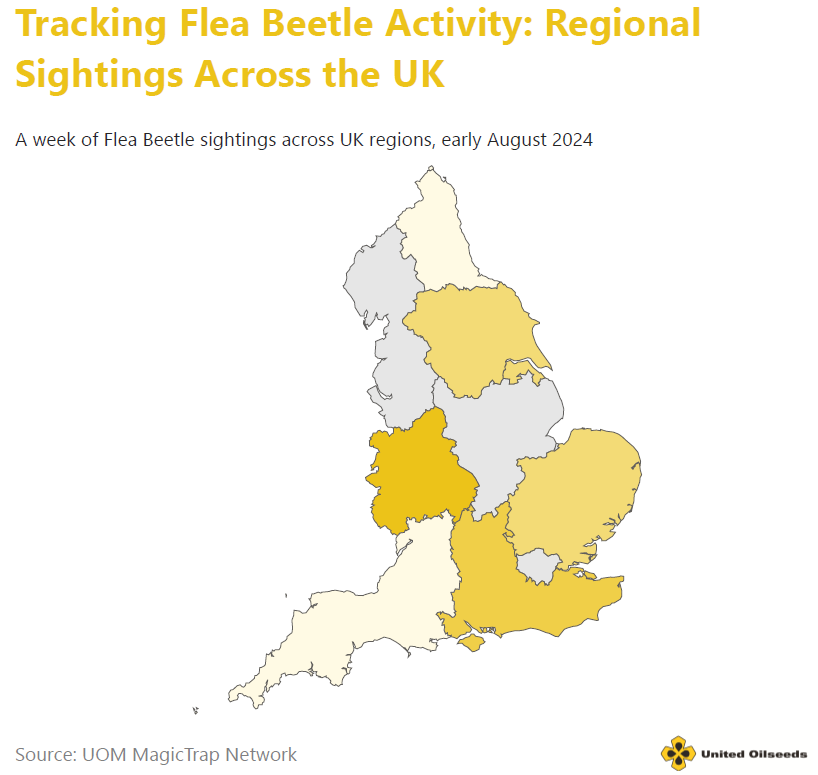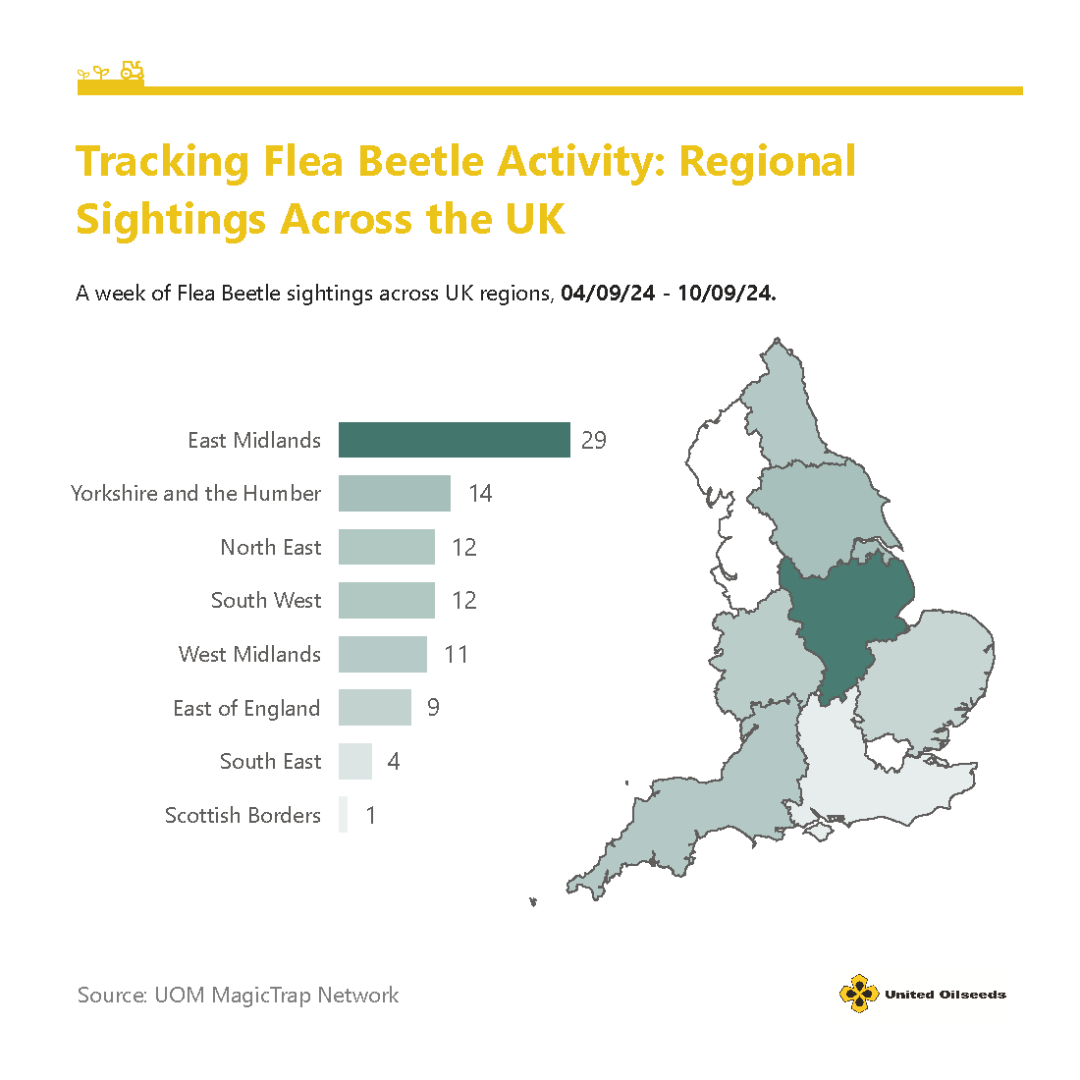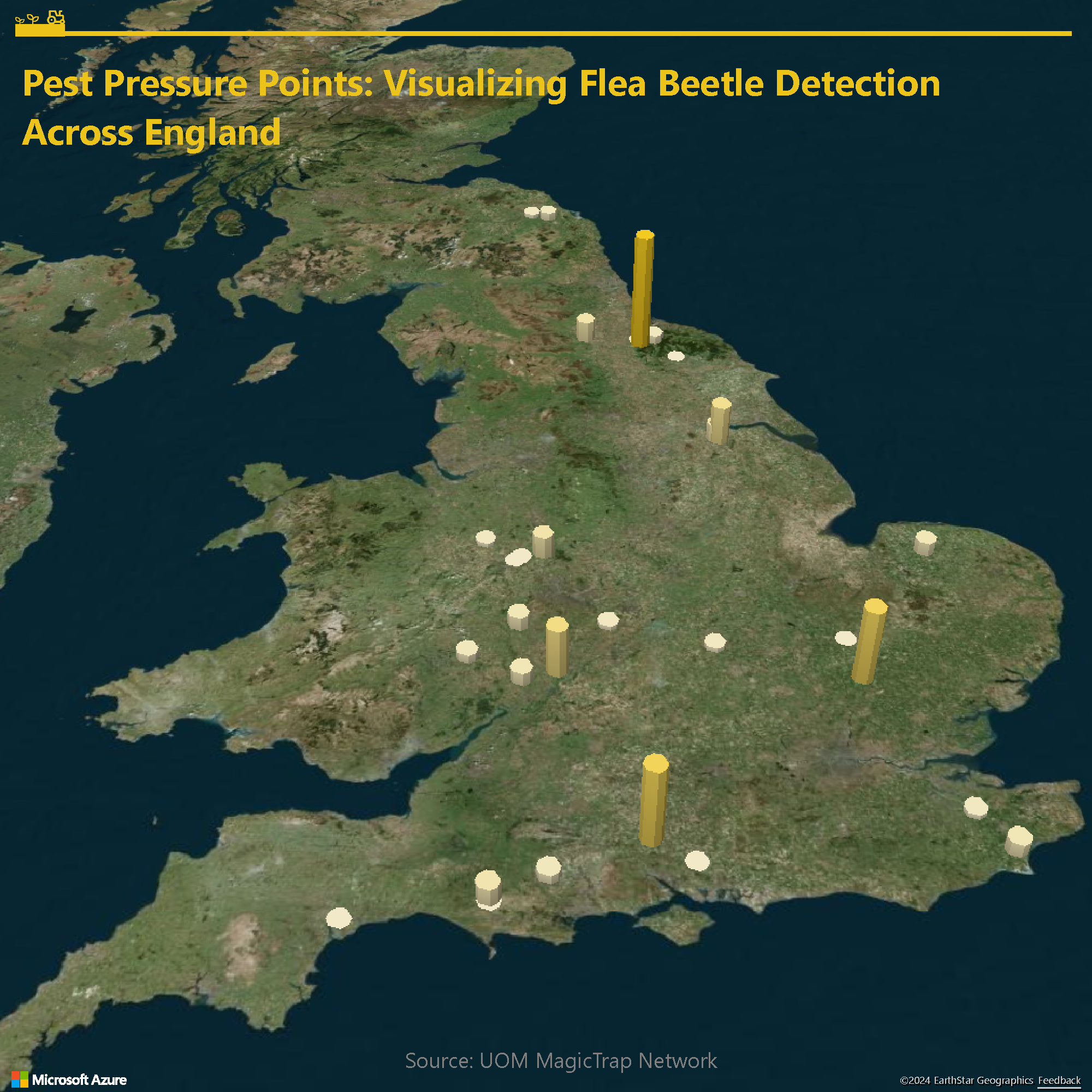
Welcome back to the MagicTrap network weekly update, which we’ve decided to change to a bi-weekly update, as we move into mid October. With OSR sowings across the country now complete, one might argue that the flea beetle information provided by the United Oilseeds MagicTrap network becomes less valuable. However, looking at the data, we’re still seeing changes in flea beetle activity which adds to the data set for comparison in future seasons/years.
Whilst naturally we have focused on CSFB for the past couple of months, come next spring we’ll also be able to monitor pollen beetle and cabbage stem weevil giving indications of pressure and timings of such pressure.
The MagicTrap network for the past couple of weeks
It’s fair to say that all regions have continued to see some new CSFB sightings since our last report. Looking at those regions over the past two and a half weeks the West Midlands has had the most sightings totalling 61, but this region has the highest number of traps in the network, so when focusing in on individual traps, it’s more of steady drip of CSFB in that region. Other regions where we have seen steady numbers of sightings within the traps include the southwest and northeast with values of 36 and 34 respectively.
Overall data so far
Today we are sharing a couple of graphs (below) depicting total numbers of CSFB from the date range 15th August to 07th October to give an idea of the trend information that is building. The data prior to the 15th August has low numbers and is therefore removed so that we can fit the graph on our website!
Looking at the first graph below, this shows total numbers of CSFB for each DEFRA region across all traps in that region. Aligning with our previous reports, the areas with the highest cumulative totals across the date range are the west Midlands and Yorkshire & the Humber. We thought this type of graph will become most useful for our readers and members to give trends within their own region.
Finally, looking at the second graph below, which amalgamates the previous graph data to give total cumulative CSFB numbers across the whole network. What we’re seeing as interesting are the green/grey plateaus within the September period. Over time we hope that by continuing to collect data we may see patterns emerging when pest pressure drops off, as in these plateaus, potentially enabling drilling decisions to be timed for emergence to coincide with these lower pressure ranges.
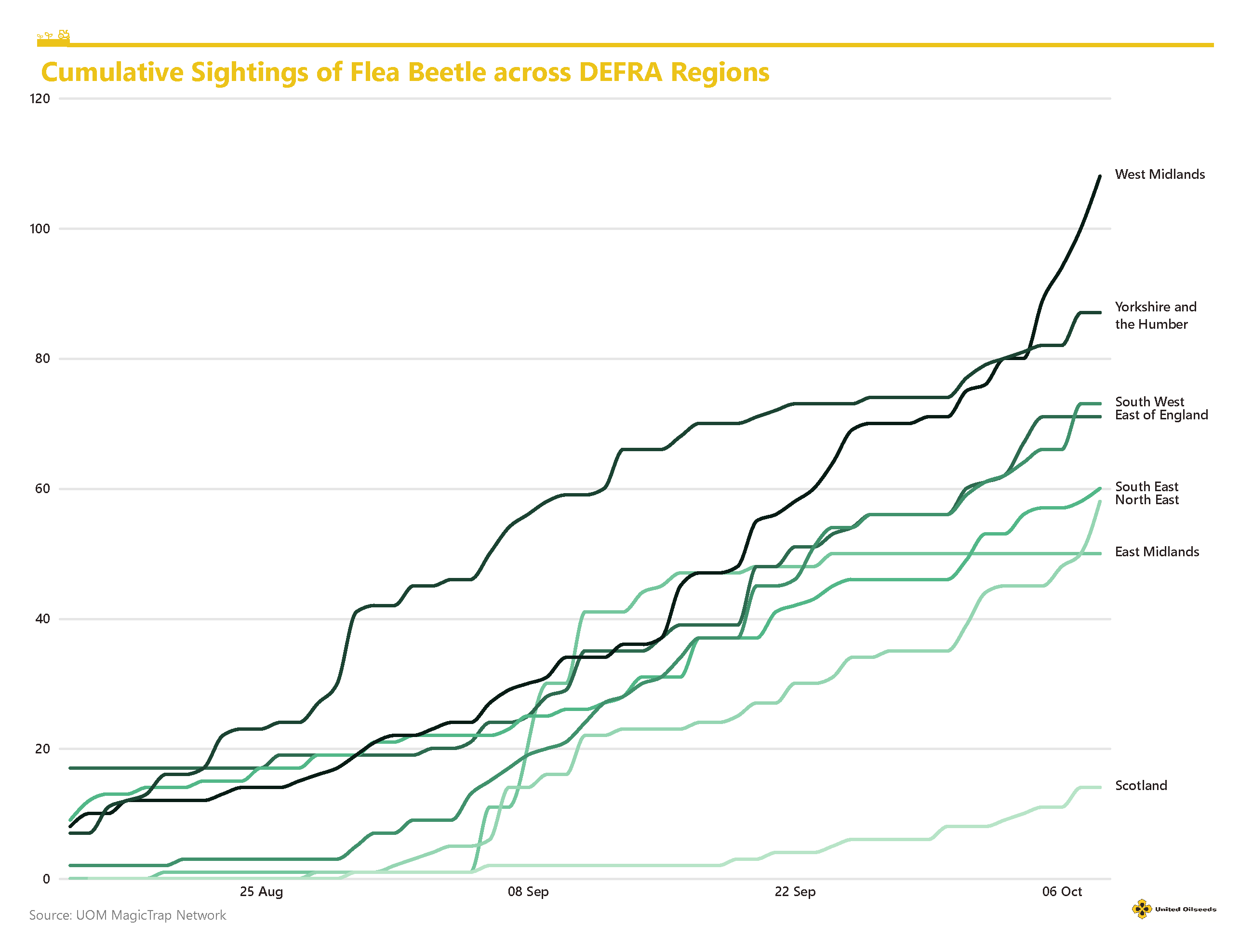
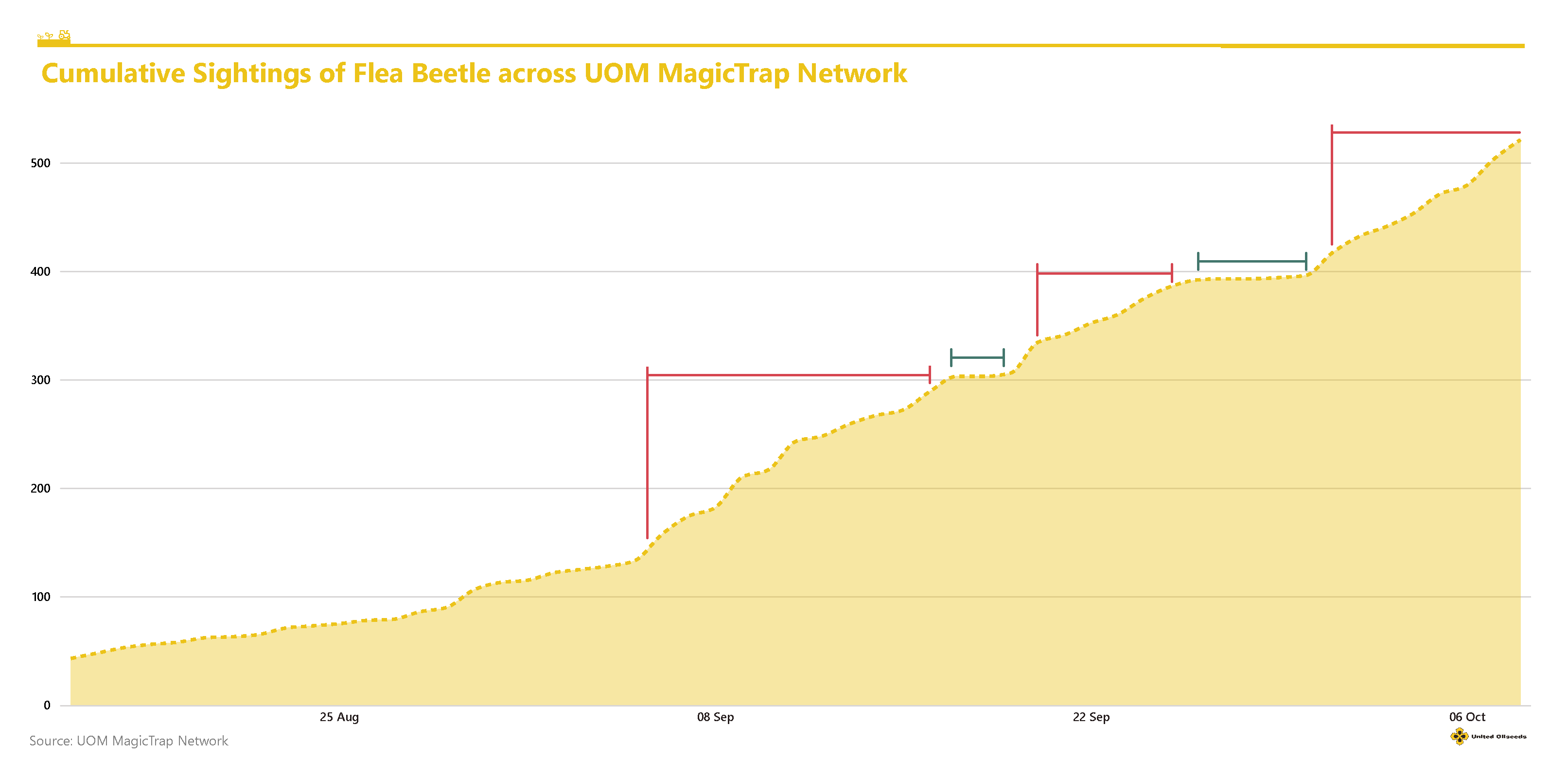
18th September - Member Poll, regional heatmap and MagicPies!?
Welcome back to the weekly MagicTrap network update. At present we are reporting using data from a total of 42 traps across the UK from both the United Oilseeds network and data shared by many of our growers who are utilising MagicTrap for the first time.
If you want any further details of MagicTrap, or for ordering and discount codes, just pop along to our MagicTrap web page in the menu at the top.
We’re kicking off this week's update with the latest member poll on the amount of flea beetle they’ve been seeing on farms across the country. As you’ll see from the graph below, there’s not too much change from our last poll of two weeks ago. The totals for people seeing ‘some’, ‘many’, or ‘lots’ have increased slightly from 33.7% to 36.8% but nothing more noticeable than that.
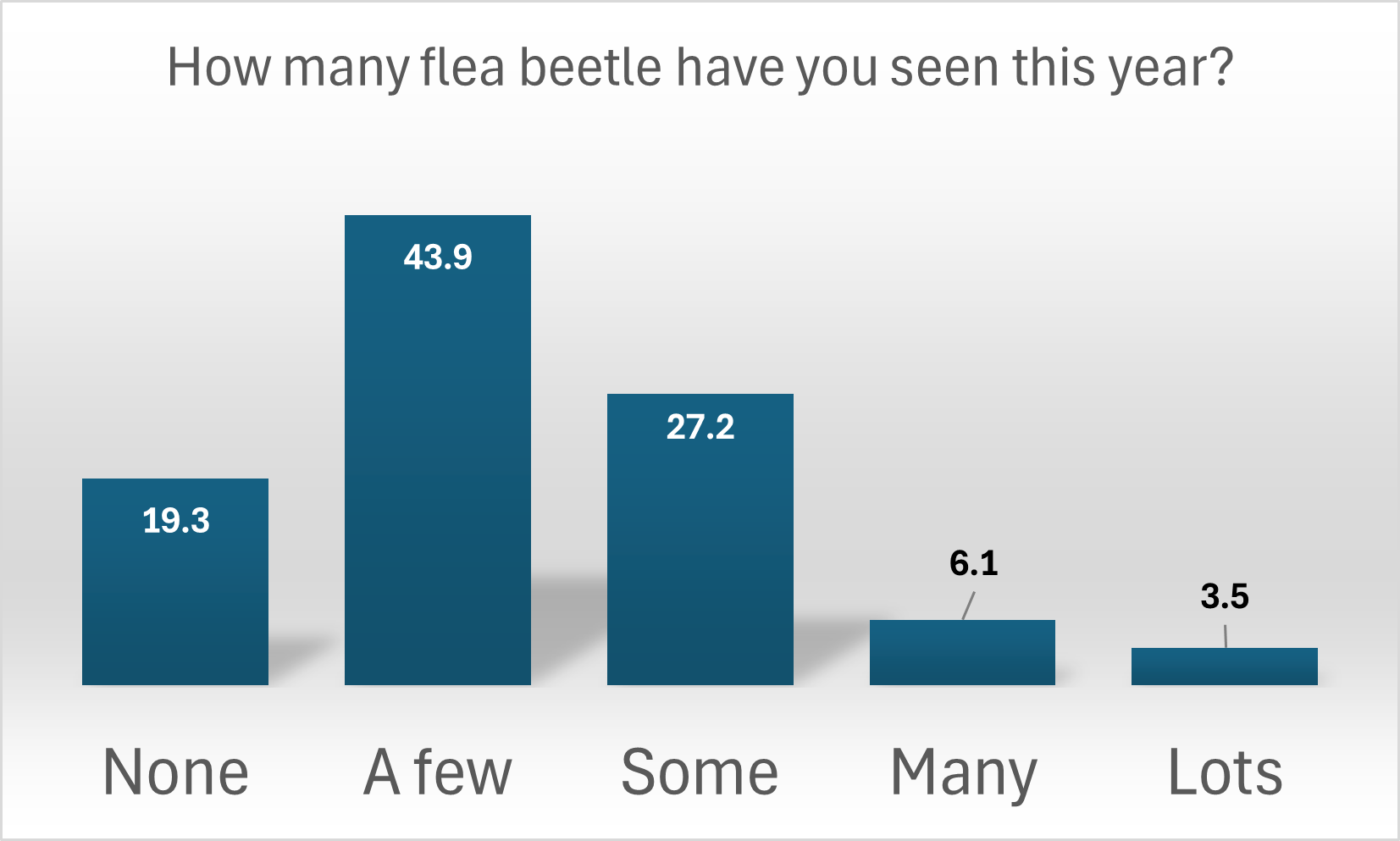
Taking a look at the MagicTrap network (see heatmap below), the West Midlands and South West regions remain in the top three listings for weekly counts of flea beetle with totals of 17 in each region. A notable drop off is observed in the East Midlands, where last week we reported a total of 17 beetles, compared to this week’s total of 3, likewise in Yorkshire & Humber, dropping down from 11 to 3. Another point to note is in the East of England where there has been an increase from 10 to 14.
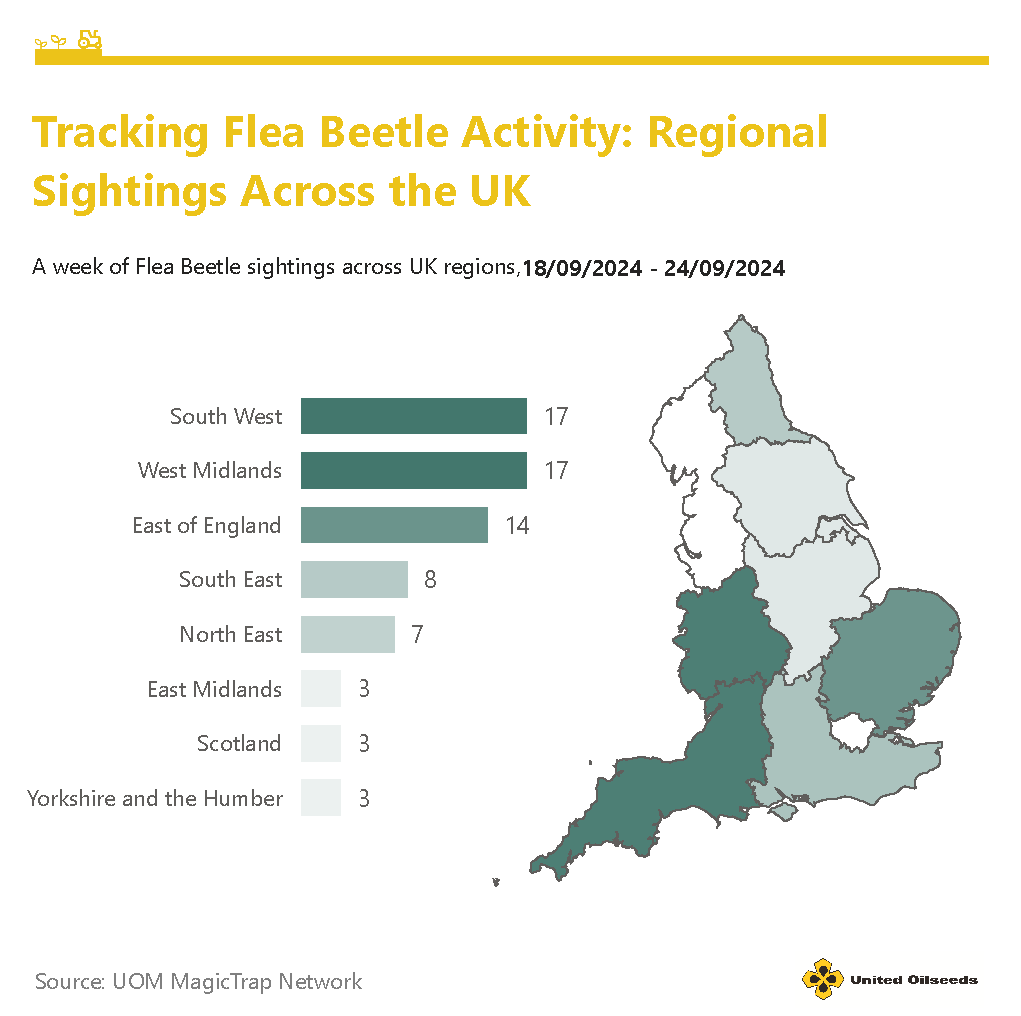
Lastly we want to share some information on the monthly shift in total CSFB detection across the DEFRA regions. Looking at the MagicPies below its interesting to note that during the month of August, 84% of beetle reporting was accounted for by just three regions, those being the West Midlands, South East and Yorkshire and Humber. However, as we’ve moved into September there has been a noticeable spread of detections across the different regions.
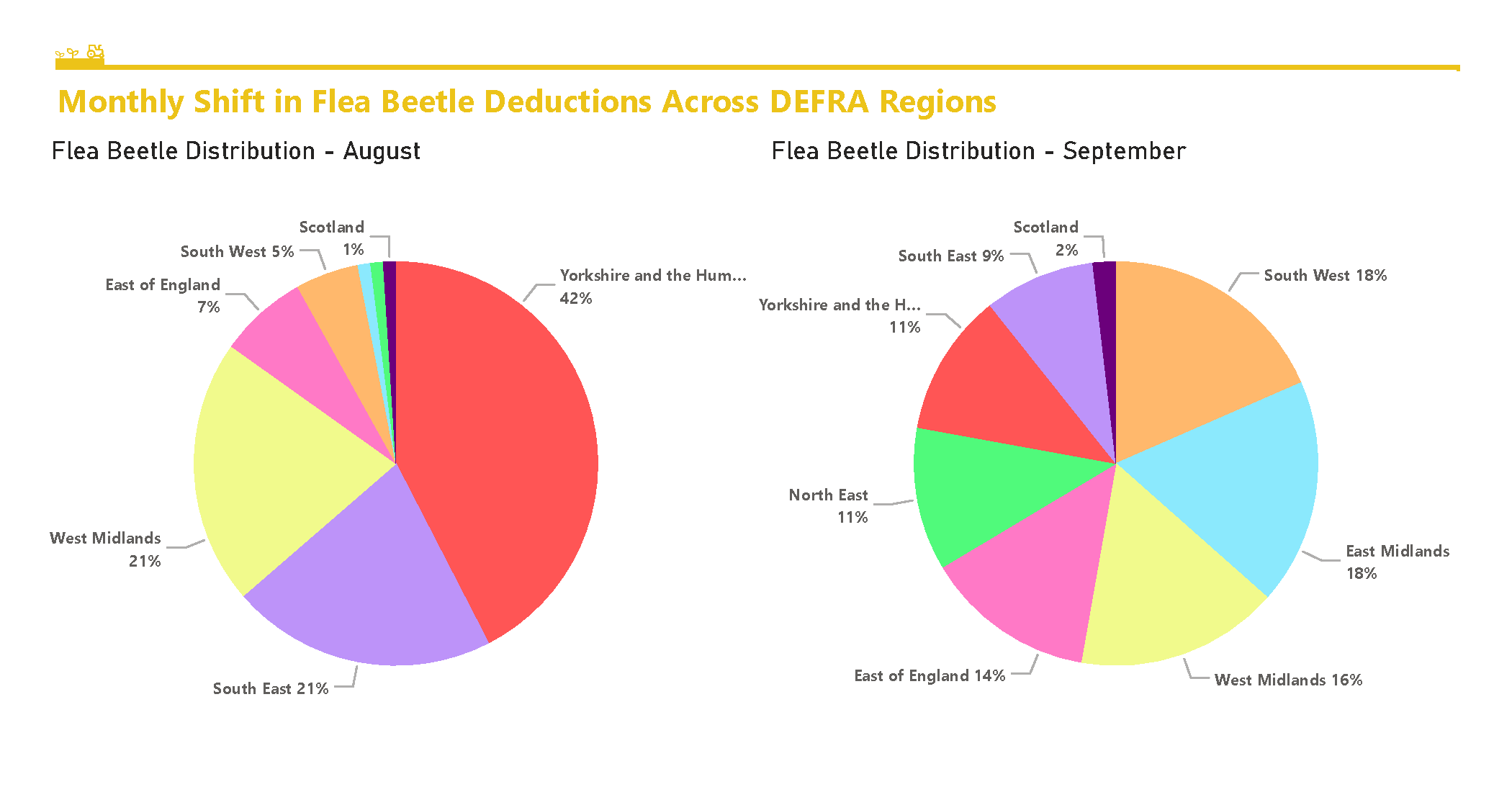 As oilseed rape plantings become less frequent across the country we hope that the information provided in these updates has been both interesting and useful. As we’ve said previously, the first year of data collection will help to lay the foundation for more meaningful data in the years ahead. We’ve already learnt a lot from trialling this network over the past 3 months and we’re looking forward to improving and growing the network to make the data provided even more useful for our valued members and the wider farming community.
As oilseed rape plantings become less frequent across the country we hope that the information provided in these updates has been both interesting and useful. As we’ve said previously, the first year of data collection will help to lay the foundation for more meaningful data in the years ahead. We’ve already learnt a lot from trialling this network over the past 3 months and we’re looking forward to improving and growing the network to make the data provided even more useful for our valued members and the wider farming community.
18th September - Pressures remains variable with steady numbers reported
Another week passes by, and we’re heading down hill to October all of a sudden. With plenty of OSR drilled we are still seeing the odd sale of seed at this slightly later stage.
We’ve had a few conversations this week about pest pressure in general, and from a couple of those conversations, it’s not the CSFB that’s been the main concern. It’s the slugs! (Should you happen to still need any slug pellets, we have supplies of all the top varieties including Sluxx, Gusto Iron and Ferrex). However, in other conversations, we are still hearing of some CSFB pressure, but still at lower levels than we’ve seen in previous years overall. Talking to a few of our Scottish growers, they have also started to report seeing some CSFB this season.
The United Oilseeds MagicTrap update
In general it’s fair to say that the amount of beetles found in our traps over the course of the past week has seen a general rise across most areas. Looking at the first graph below, the largest increase when compared to the cumulative total of beetles last week is in the Southwest, where the trap saw 16 CSFB compared to 12 last week. The other area across our network that has seen a slight increase from 11 to 13 is the West Midlands.
Where previously we had seen the highest populations in the East Midlands and Yorkshire and Humber, we have seen reductions of 12 and 3 CSFB respectively in those areas when compared to last weeks figures.
Looking at the latest AHDB update, they are still reporting the highest numbers in their Cambridgeshire trap, with little increases in numbers across other traps.
Other points to note are an increase in pollen beetle sightings in some areas as highlighted in the bar graph below.
Next week we’ll be sharing details of a fresh poll to see what our valued members are reporting on the ground.
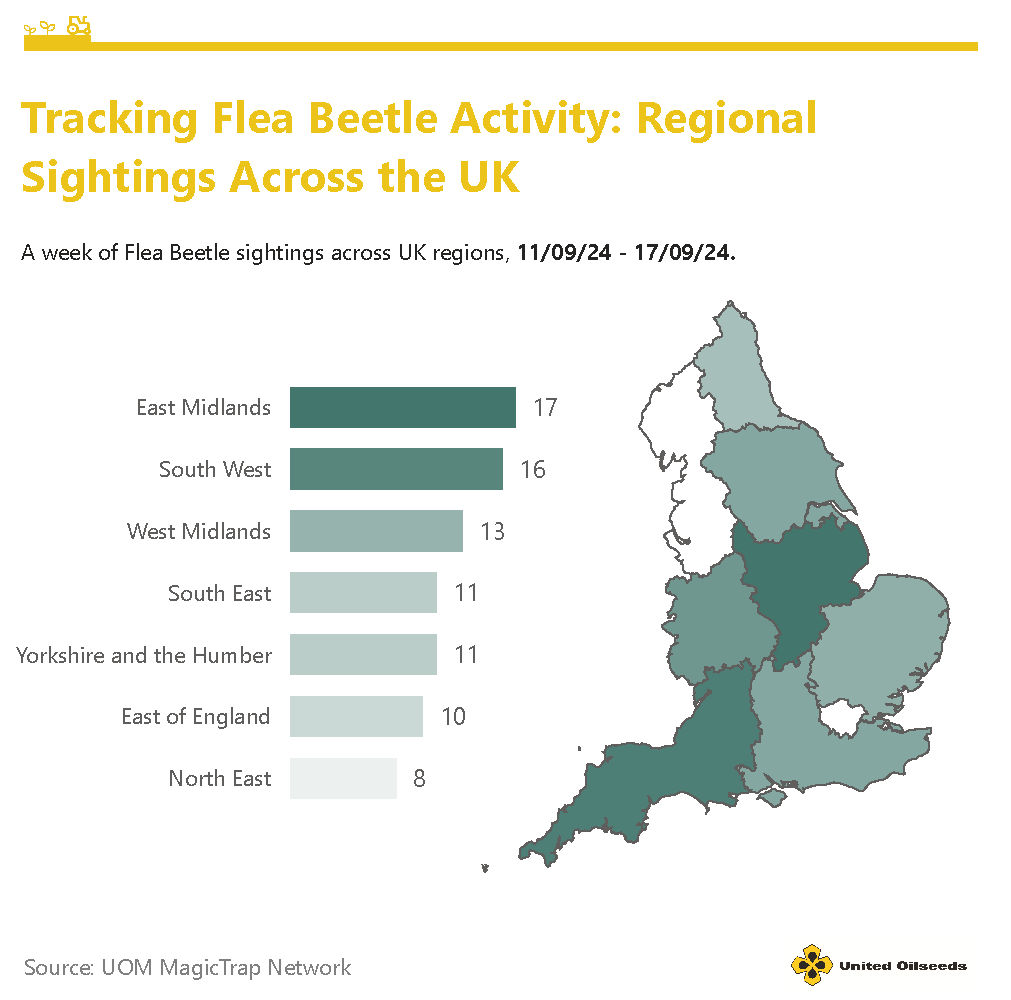
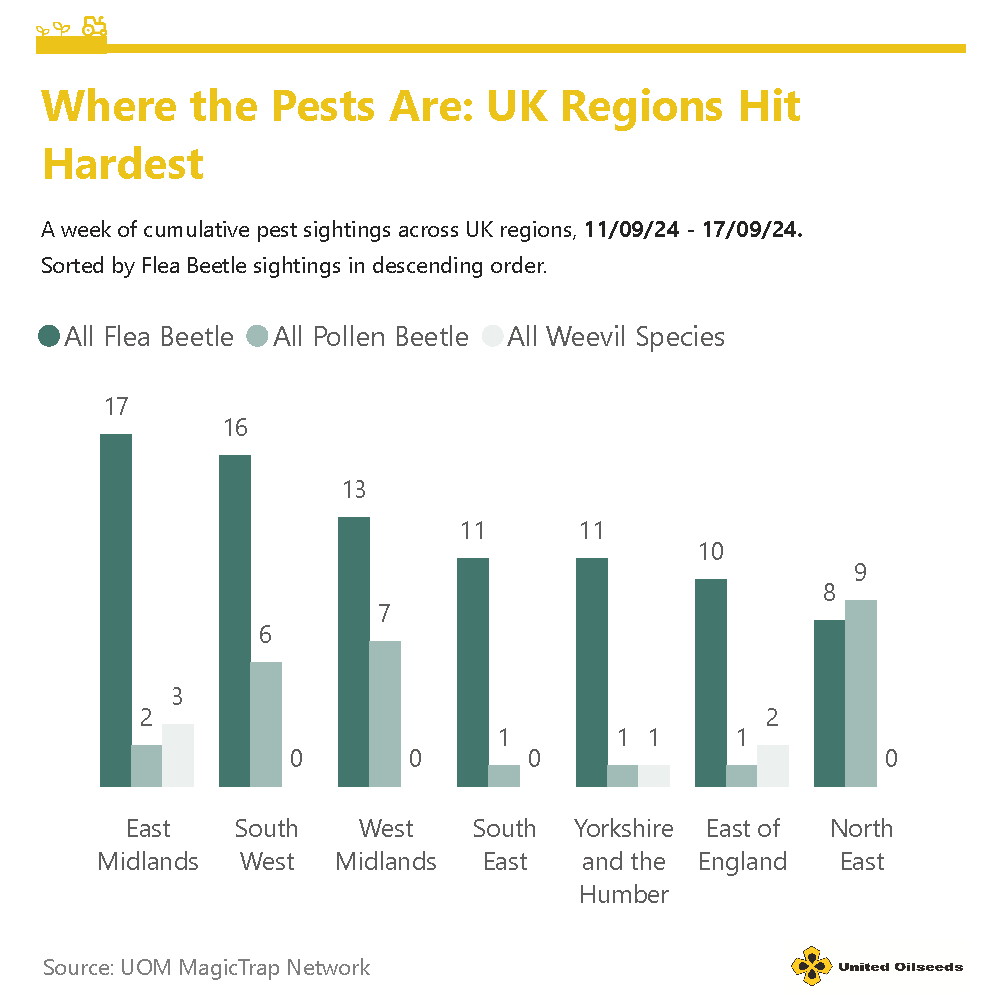
11th September – Increased activity & some isolated incidents
When we sent an email to our members this week with the subject ‘Guess who’s back?’ the question was raised, ‘is it the flea beetle?’ and while we have seen notable increases in some regions, it was actually a reference to us asking members to respond to a third email poll about the pest pressure they are seeing! CSFB returning certainly isn’t something we’d quip about.
That said, it is great to be able to compare such fresh data from three different sources, those being our network, the AHDB network and the primary research of our members.
Enough waffle, down to the nitty gritty.
Over the past week, we’ve observed a rise in CSFB activity, particularly in the Yorkshire & Humber region, where numbers have increased by 7 compared to the previous week. More significantly, in the East Midlands, we’ve gone from zero beetles in the trap to 29. On Wednesday, 6th September, 10 CSFB were caught, followed by an additional 19 over the 9th.
What makes this especially noteworthy is the location of our East Midlands trap, which is only 40 miles from the AHDB Cambridgeshire monitoring site, where they have recorded the highest CSFB counts in any of their traps. Adding to this, a report from one of our East Midlands growers about a heavy infestation another 40 miles northwest of our trap suggests a potential pressure band across the region.
In general and compared to the prior three weeks of reporting there has been increased trap activity in the following regions:
- North East changing from 4 to 12 CSFB
- South West changing from 6 to 12 CSFB
- West Midlands changing from 8 to 11 CSFB
- East of England changing from 1 to 4 CSFB
Finally, looking at our recent CSFB poll to United Oilseeds members, here’s what they are seeing:
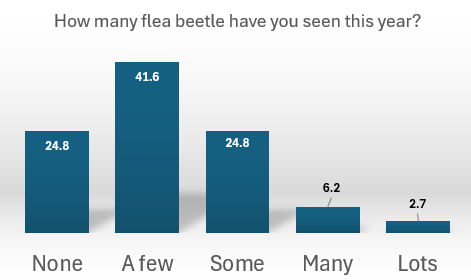
Compared to two weeks ago, 66.4% of respondents are seeing none or a few compared to 85.3% two weeks ago. Also of note is that the percentage of members seeing some CSFB has increased from 6.9% to 24.8% but those seeing many or lots hasn’t changed too much rising to 8.9%
Be sure to check back next week when we’ll provide a further update.
03rd September - Some activity over the weekend
Welcome back to the weekly MagicTrap network update. We’re happy to report that CSFB pressure remains low across both our MagicTrap network and the shared network.
However, there are a few minor updates to note. We've observed a slight increase in pressure in the Yorkshire and Humber region, with a small spike over the weekend of August 31st to September 1st. Additionally, minor spikes were detected in the southwest and southeast regions during the same period, though we're only seeing 2 or 3 beetles in each area, so it doesn’t appear significant.
In the AHDB network of MagicTraps, the latest data shows a rise in numbers in the Cambridgeshire and Suffolk traps.
See the map below for a graphical representation of where traps are located and indications of the different sightings across regions.
What can we conclude so far?
Based on the current data, it appears that CSFB pressure is significantly lower this year compared to previous years. Reports from our growers support this observation, though it’s important to note that certain areas still have substantial CSFB presence. However, without concrete data from last year, we can’t be entirely certain. The slightly higher pressure in Yorkshire and in the AHDB traps in the east serves as a reminder that pest pressure can vary widely even within the same county, depending on the location of individual traps.
The key takeaway is that we must continue gathering data. Over time, this will strengthen the network's ability to provide valuable insights for growers nationwide.
Comments from the field gleaned this week
Area Manager for Midlands and Norfolk James Hood made a point of contacting a geographical spread of his growers this past week with a very positive response and no negativity at all. Here are a couple of the comments:
“some of the best for years, with no CSFB pressure at all”
“It almost looks too good”
“no beetle in the Magic Trap. Last year it would have been full!”
27th August - CSFB pressure is low, pollen beetle most prolific
Similarly to the AHDB MagicTrap network, we are still seeing relatively low numbers of CSFB across the United Oilseeds network. The highest numbers observed continue to be in the Yorkshire and Humber region shown on the graph below with a total of 11 cabbage stem flea beetles recorded this past week.
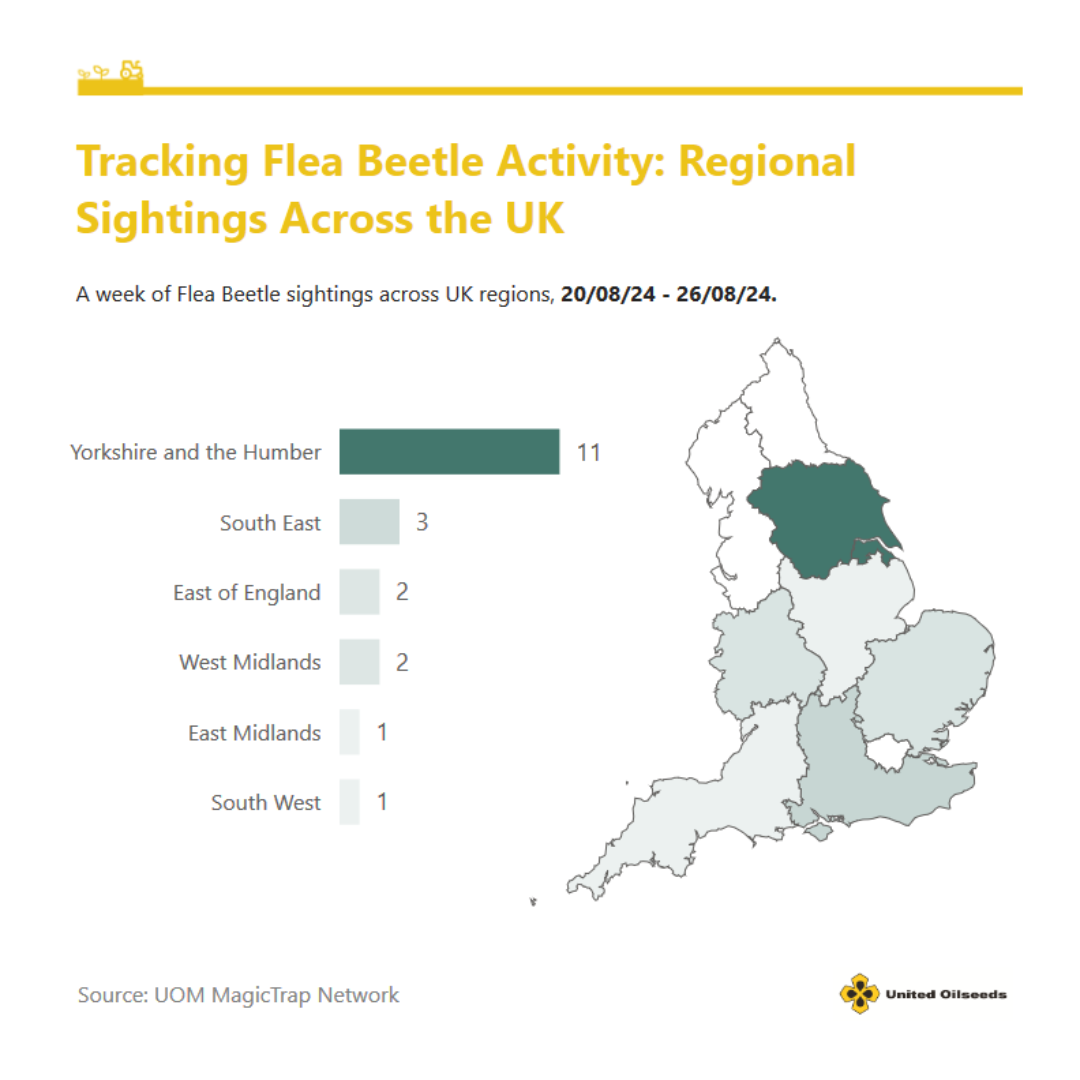
We also re-ran our poll of a few weeks ago to see what our members are experiencing across the country. At last count their sightings seem to agree with the network with 85.3% of responders seeing none or a few flea beetle and just 2.9% seeing lots.
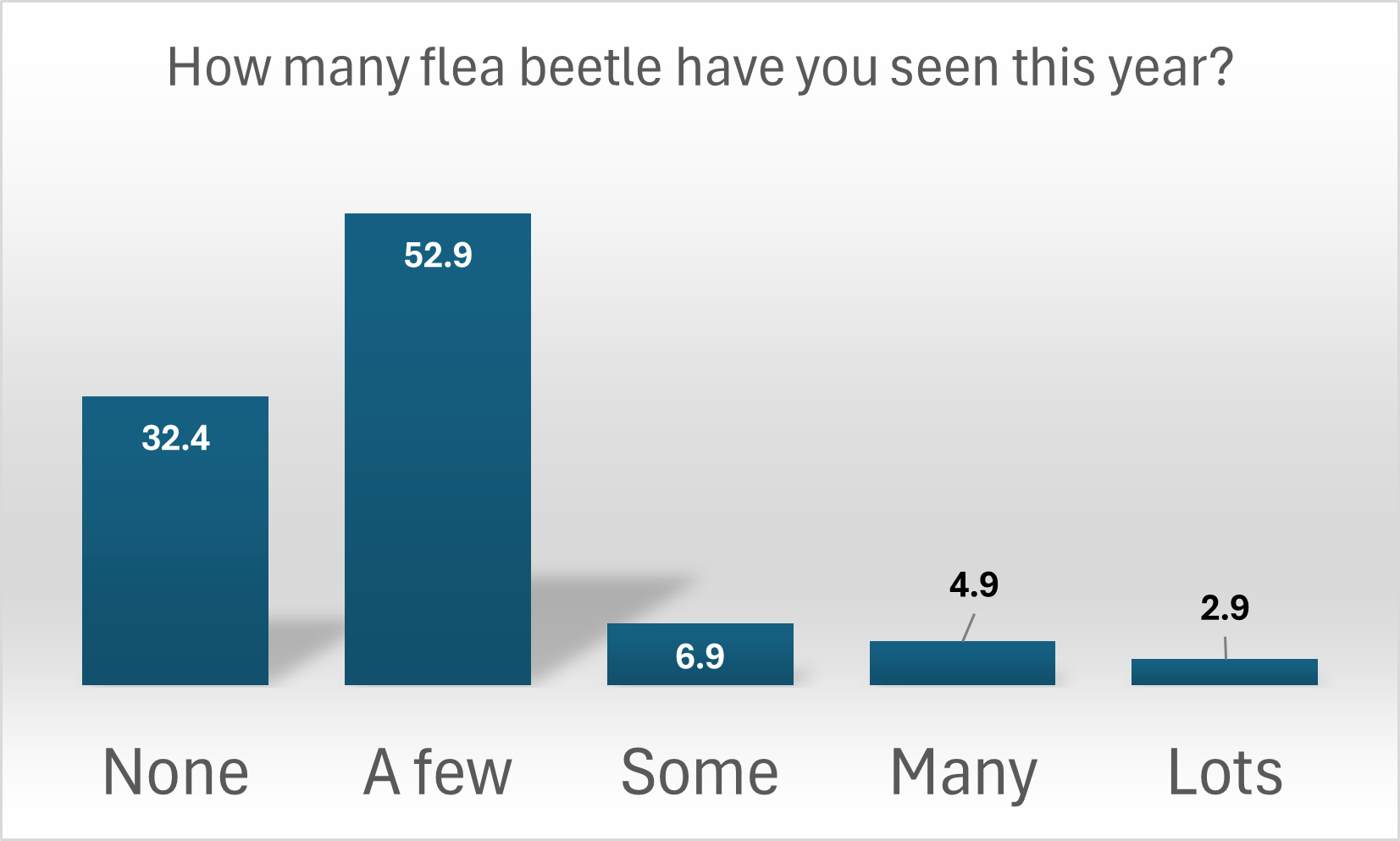
While the three sources all show relatively low numbers of CSFB, via conversations with farmers, we do understand that there are some hotspots of CSFB still prevalent across the country which have impacted newly sown OSR crops. However, with the Magic Trap network(s) fixed at certain sites, there is no way for it to pick up all activity in all regions, but as we have previously stated, data gathered this year will become more meaningful over time.
20th August - Pest pressure relatively low across the country
Firstly, you may have seen the announcement last week from the AHDB and NIAB confirming that they have also set up a network of MagicTraps around the country and will be sharing data twice per week. This is great news for growers across the UK as it will provide another source of valuable data to support decision making. You can read more about the project on the Farming UK website here, and check the data on the AHDB website here. (Scroll slightly)
The United Oilseeds MagicTrap network update
What is it they say, no news is good news?
There’s not too much to report form our own MagicTrap network at the moment. Pest pressure remains low in all of our traps, with the exception being in the Yorkshire and Humber region which has seen a small spike in numbers over the weekend, matching the same figures as the previous weekend but still nothing to suggest there’s a surge at present.
With the bank holiday approaching and various research articles suggesting that the main driver for CSFB activity is hot weather, maybe it’s not so bad that temperatures this weekend are set to be distinctly average for the time of year.
While we fine tune our MagicTrap network, the data provided at this stage should be regarded as indicative of the current pressure across different regions. We are working diligently to enhance and expand the network’s capabilities, and we expect that after a full year of data collection, a control benchmark will be established, allowing for more precise and meaningful insights.
Users are encouraged to keep these factors in mind when relying on the network for critical or time-sensitive decisions. We appreciate your understanding and patience as we continue to improve and refine the network.
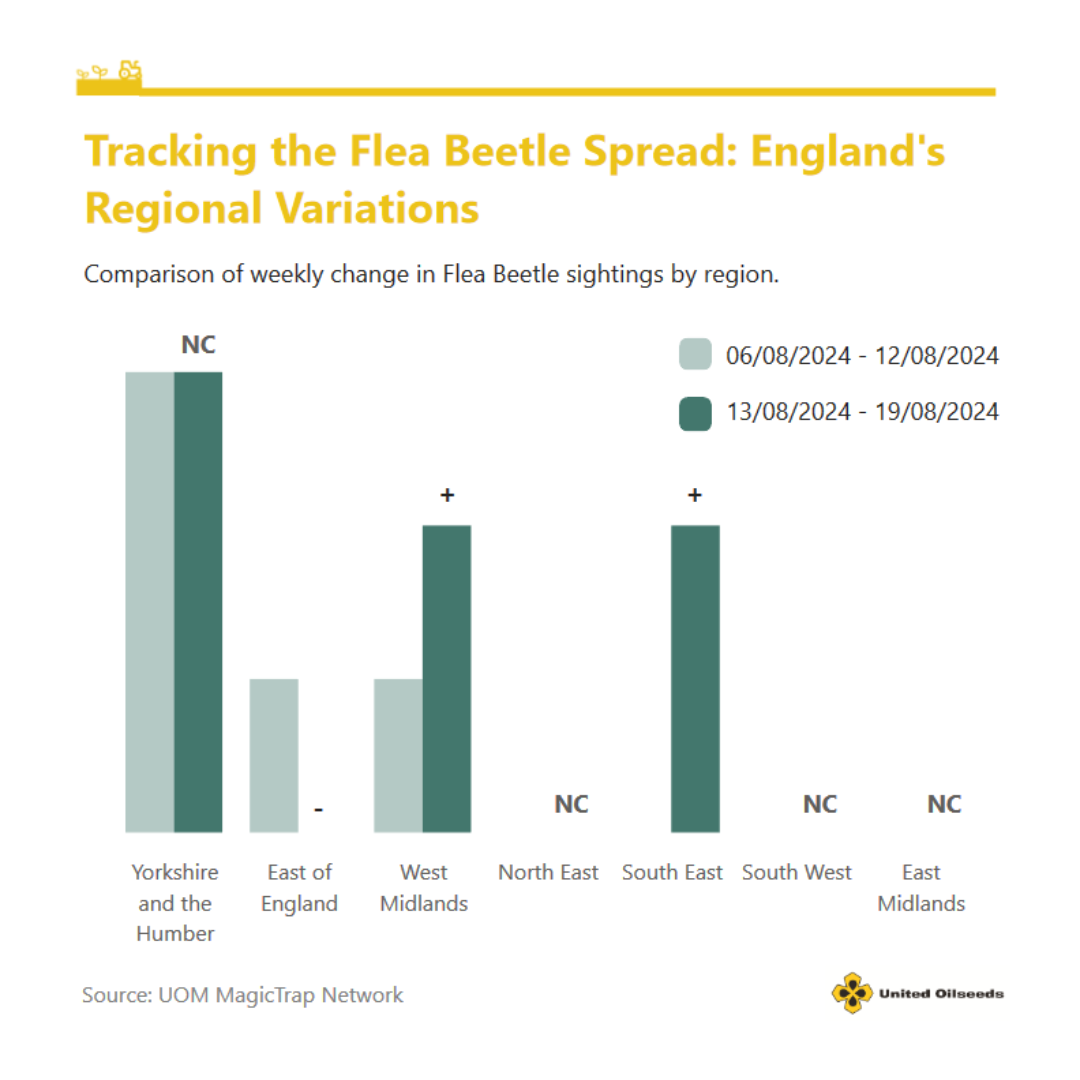
13th August - Pest pressure seemingly low at this stage
With the roll out of Bayer’s MagicTrap now in full swing United Oilseeds has been keeping a close eye on what the current Cabbage Stem Flea Beetle (CSFB) pressure is like across the UK.
With 20 United Oilseeds traps already out in the field and many more member traps joining the network we’re pleased to report that pest pressure at present seems to be low, particularly when compared to some of the stories and images we were seeing last year.
"Without a doubt, we are seeing a lot less flea beetle in and around the OSR sheds so far this season than we have seen in recent years," says Leicestershire farmer and storekeeper at Welland Grain, Jeremy Farmer.
Andrew Pearcy a regular OSR grower from Tadcaster North Yorks commented: “We have seen absolutely no flea beetle at all this year. We sowed the new crop on 31 July and with a little bit of timely moisture the seed germinated within 6 days and looks completely unscathed."
Asked what he puts the lack of CSFB down to Andrew said: “The only difference that we’ve noted this year is the amount of rain we had for 6-7 months, so maybe they all drowned!”
Mr Pearcy was one of the United Oilseeds members who responded to our recent poll asking farmers what pest pressure had been like this year, and judging by the responses there is definitely low pressure at the moment. Out of all responders, 72.3% said they’d seen none or a few, or 91.3% said they’d seen none/a few/some.
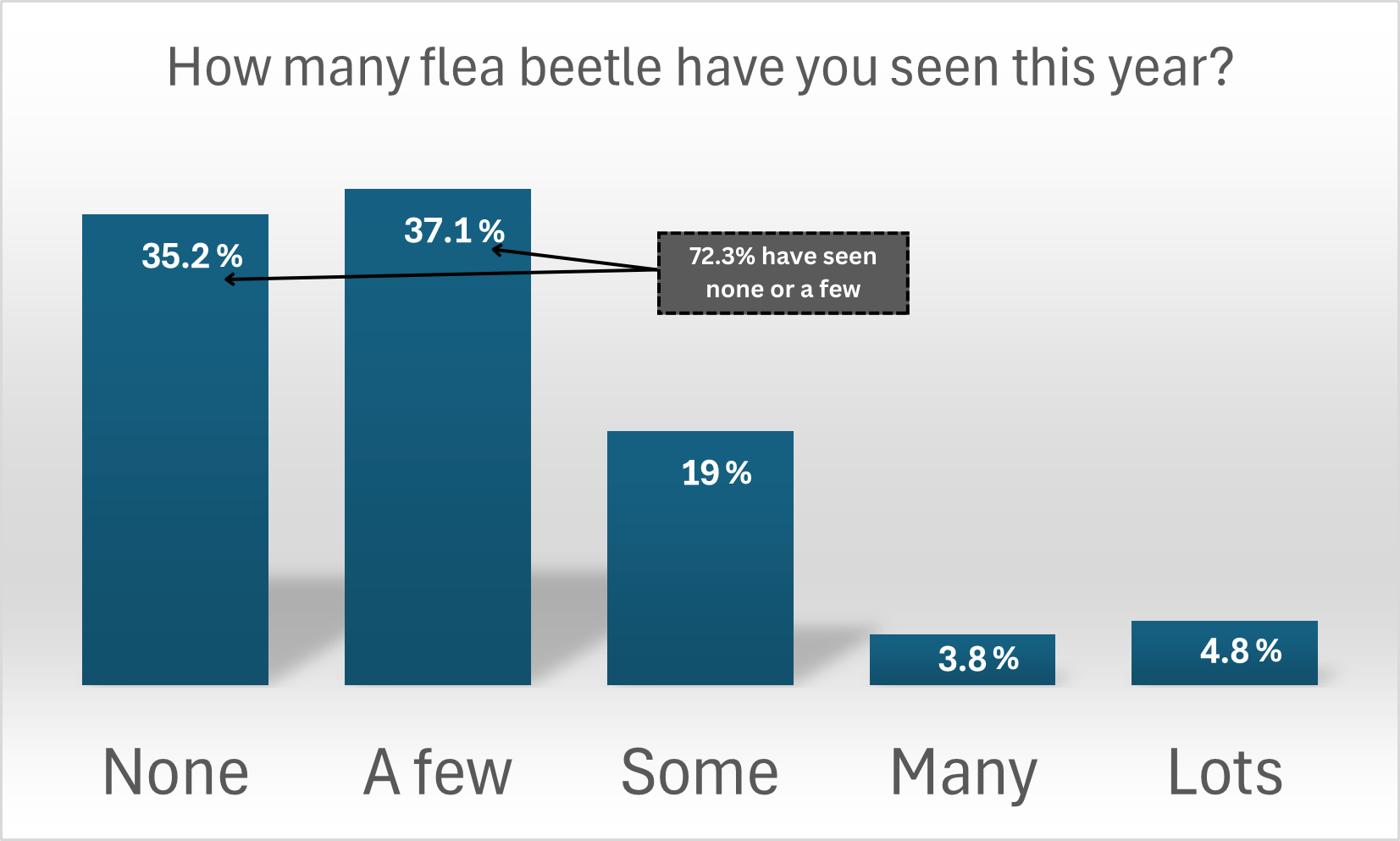
Source: United Oilseeds member poll on Friday 09th August 2024
United Oilseeds Managing Director James Warner said: “The collection and transparent sharing of aggregated data, whether through MagicTrap, surveys, or anecdotal evidence, will become more and more important in our fight against CSFB. It’s certainly positive to hear that CSFB appears to be less of a problem so far this year. That’s not to say there are none, and we are still ahead of the typical migration window, but from the conversations I’m having with growers it is notably different to last year.”
Here at United Oilseeds we will continue to monitor pest pressure via the MagicTrap network, particularly over the crucial next month. We commit to sharing as much information with our members as possible to help the decision-making process on drilling dates.
The heatmap below is based on extremely low CSFB numbers, but provides an insight to the kind of reporting that the United Oilseeds MagicTrap network will be providing over the coming weeks and months.
